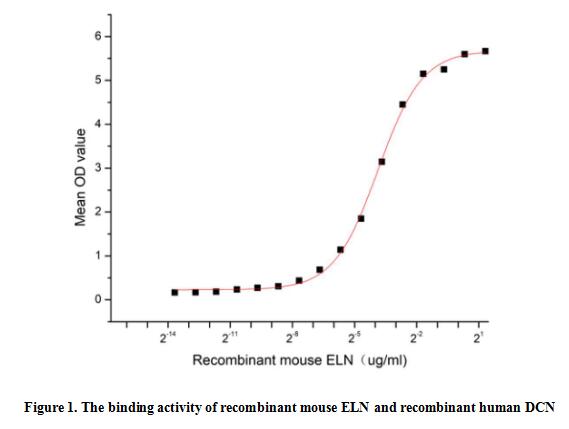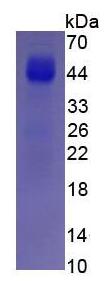Active Elastin (ELN) 

WBS, WS, SVAS; Tropoelastin; Supravalvular Aortic Stenosis; Williams-Beuren Syndrome
- UOM
- FOB US$ 278.00 US$ 696.00 US$ 1,392.00 US$ 4,176.00 US$ 10,440.00
- Quantity
Overview
Properties
- Product No.APB337Mu01
- Organism SpeciesMus musculus (Mouse) Same name, Different species.
- ApplicationsCell culture; Activity Assays.
Research use only - DownloadInstruction Manual
- CategoryMetabolic pathwayDevelopmental science
- Buffer FormulationPBS, pH7.4, containing 0.01% SKL, 5% Trehalose.
- Traits Freeze-dried powder, Purity > 95%
- Isoelectric Point9.3
Sign into your account
Share a new citation as an author
Upload your experimental result
Review

Contact us
Please fill in the blank.
Activity test

Elastin (ELN) is an extracellular matrix (ECM) protein responsible for the extensibility and elastic recoil of many vertebrate tissues. ELN is abundant in elastic tissues, and tissues rich in elastin include the aorta and major blood vessels, the lungs, elastic ligaments, tendons and the skin. ELN can bind the elastin receptor complex and other receptors and stimulate migration and proliferation of monocytes and skin fibroblasts. Elastokines can also contribute to cancer progression. Deletions and mutations in this gene are associated with supravalvular aortic stenosis (SVAS), autosomal dominant cutis laxa. Decorin (DCN), an extracellular matrix (ECM) protein, is one of targets of ECM. Thus a functional binding ELISA assay was conducted to detect the interaction of recombinant mouse ELN and recombinant human DCN. Briefly, ELN was diluted serially in PBS with 0.01% BSA (pH 7.4). Duplicate samples of 100 μl were then transferred to DCN-coated microtiter wells and incubated for 1h at 37℃. Wells were washed with PBST and incubated for 1h with anti-ELN pAb, then aspirated and washed 3 times. After incubation with HRP labelled secondary antibody for 1h at 37℃, wells were aspirated and washed 5 times. With the addition of substrate solution, wells were incubated 15-25 minutes at 37℃. Finally, add 50 µL stop solution to the wells and read at 450/630 nm immediately. The binding activity of recombinant mouse ELN and recombinant human DCN was shown in Figure 1, the EC50 for this effect is 0.068 ug/mL.
Usage
Reconstitute in 10mM PBS (pH7.4) to a concentration of 0.1-1.0 mg/mL. Do not vortex.
Storage
Avoid repeated freeze/thaw cycles. Store at 2-8°C for one month. Aliquot and store at -80°C for 12 months.
Stability
The thermal stability is described by the loss rate. The loss rate was determined by accelerated thermal degradation test, that is, incubate the protein at 37°C for 48h, and no obvious degradation and precipitation were observed. The loss rate is less than 5% within the expiration date under appropriate storage condition.
Increment services
-
 BCA Protein Quantification Kit
BCA Protein Quantification Kit
-
 Molecular Mass Marker for Protein
Molecular Mass Marker for Protein
-
 Monoclonal Antibody Customized Service
Monoclonal Antibody Customized Service
-
 Polyclonal Antibody Customized Service
Polyclonal Antibody Customized Service
-
 Protein Activity Test Experiment Service
Protein Activity Test Experiment Service
-
 Electrophoretic Mobility Shift Assay (EMSA) Experiment Service
Electrophoretic Mobility Shift Assay (EMSA) Experiment Service
-
 Buffer
Buffer
-
 Lentivirus Packaging Experiment Service
Lentivirus Packaging Experiment Service
-
 Adenovirus Packaging Experiment Service
Adenovirus Packaging Experiment Service
-
 Real Time PCR Experimental Service
Real Time PCR Experimental Service
-
 Spike RBD Protein (S-RBD)
Spike RBD Protein (S-RBD)
-
 Protein G
Protein G
-
 Protein A
Protein A
Citations
- Induction of elastin expression in vascular endothelial cells relates to hepatoportal sclerosis in idiopathic portal hypertension: possible link to serum anti-endothelial cell antibodiesPubMed: 22288597
- Protein synthesis and secretion in human mesenchymal cells derived from bone marrow, adipose tissue and Wharton's jelly.Pubmed: 24739658
- A dietary supplement improves facial photoaging and skin sebum, hydration and tonicity modulating serum fibronectin, neutrophil elastase 2, hyaluronic acid and carbonylated proteinsPubmed:25732262
- Mesenchymal stromal cell proliferation, gene expression and protein production in human platelet-rich plasma-supplemented mediaPubmed:Pmc4130592
- Effects of Exendin-4 on human adipose tissue inflammation and ECM remodelling.pubmed:27941938
- Anti-ageing effects of Ubiquinone and Ubiquinol in a senescence model of human dermal fibroblasts33482334
- GENE THERAPY DNA VECTOR VTvaf17, METHOD OF PRODUCTION; ESCHERICHIA COLI STRAIN SCS110-AF, METHOD OF PRODUCTION; ESCHERICHIA?¡
- CLINICAL SIGNIFICANCE OF LAMININ AND ELASTINE LEVELS IN CHILDREN WITH UNDIFFERENTIATED CONNECTIVE TISSUE DISEASE







